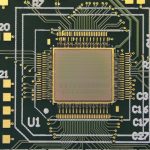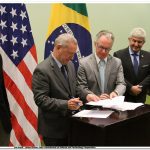From Space.com, April 15, 2020: A new study from the T2K experiment looked hard for signs of CP symmetry violation in neutrinos and came up with some intriguing results. The international Deep Underground Neutrino Experiment, hosted by Fermilab, will provide complementary techniques and measurements that may provide a more definitive answer in the quest for CP violation.
DUNE
From Science, April 15, 2020: Neutrinos behave differently from their antimatter counterparts, antineutrinos, report physicists on the T2K experiment. The result is far from conclusive, but the asymmetry, known as CP violation, could help explain how the newborn universe generated more matter than antimatter. NOvA spokesperson Patricia Vahle of William & Mary comments on the T2K result and NOvA’s measurements of CP violation. When the international Deep Underground Neutrino Experiment, hosted by Fermilab, comes online, it will be able to make more precise measurements of neutrinos’ behavior.
From New Scientist, April 15, 2020: Differences between matter and antimatter, called CP violation, have been measured in some particles, called quarks, but the level isn’t nearly enough to explain the observed imbalance between matter and antimatter. The T2K collaboration has observed hints that CP violation in neutrinos may be able to make up the difference. DUNE spokesperson Ed Blucher of the University of Chicago comments on the result.
From Nature, April 15, 2020: In a mirror world, antiparticles should behave in the same way as particles. But it emerges that neutrinos, electrons and their more exotic cousins might not obey this expected pattern. Fermilab scientist Jessica Turner and Durham University scientist Silvia Pascoli provide a commentary on T2K’s recent neutrino result, CP violation, and how other neutrino experiments, including the international Deep Underground Neutrino Experiment, hosted by Fermilab, will make more precise measurements of the mysterious neutrino’s behavior.
From The New York Times, April 15, 2020: An international team of 500 physicists from 12 countries, known as the T2K collaboration, reported that they had measured a slight but telling difference between neutrinos and their opposites, antineutrinos. Fermilab Deputy Director Joe Lykken comments on the result and how the international Deep Underground Neutrino Experiment, hosted by Fermilab, may be able to make a definitive discovery of CP violation.
When scientists begin taking data with the Deep Underground Neutrino Experiment in the mid-2020s, they’ll be able to peer 13.8 billion years into the past and address one of the biggest unanswered questions in physics: Why is there more matter than antimatter? To do this, they’ll send a beam of neutrinos on an 800-mile journey from Fermilab to Sanford Underground Research Facility in South Dakota. To detect neutrinos, researchers at several DOE national laboratories, including Fermilab, are developing integrated electronic circuitry that can operate in DUNE’s detectors — at temperatures around minus 200 degrees Celsius. They plan to submit their designs this summer.
From Event Horizon podcast, March 19, 2020: Fermilab scientist James Annis and John Michael Godier discuss neutrinos, dark energy, dark matter and upcoming cosmological surveys in this 30-minute interview.
From March 6, 2020: Durante a 5ª Comista, os dois países adotaram um Plano de Trabalho em Ciência e Tecnologia para o período de 2020 a 2023, que estabelece as prioridades comuns descritas acima. Também foram firmados acordos de cooperação na área de cooperação científica em Física de Partículas de Alta Energia entre o Fermilab (Laboratório de pesquisa científica do Departamento de Energia dos EUA) e a FAPESP e outro acordo na mesma área entre o Fermilab e a UNICAMP.
From the Brazil Ministry of Science, Technology, Innovation and Communication, March 6, 2020: Comissão mista entre os dois países possui grupos de trabalho para pesquisas sobre temas como saúde, espaço, tecnologias e agências de financiamentos.


